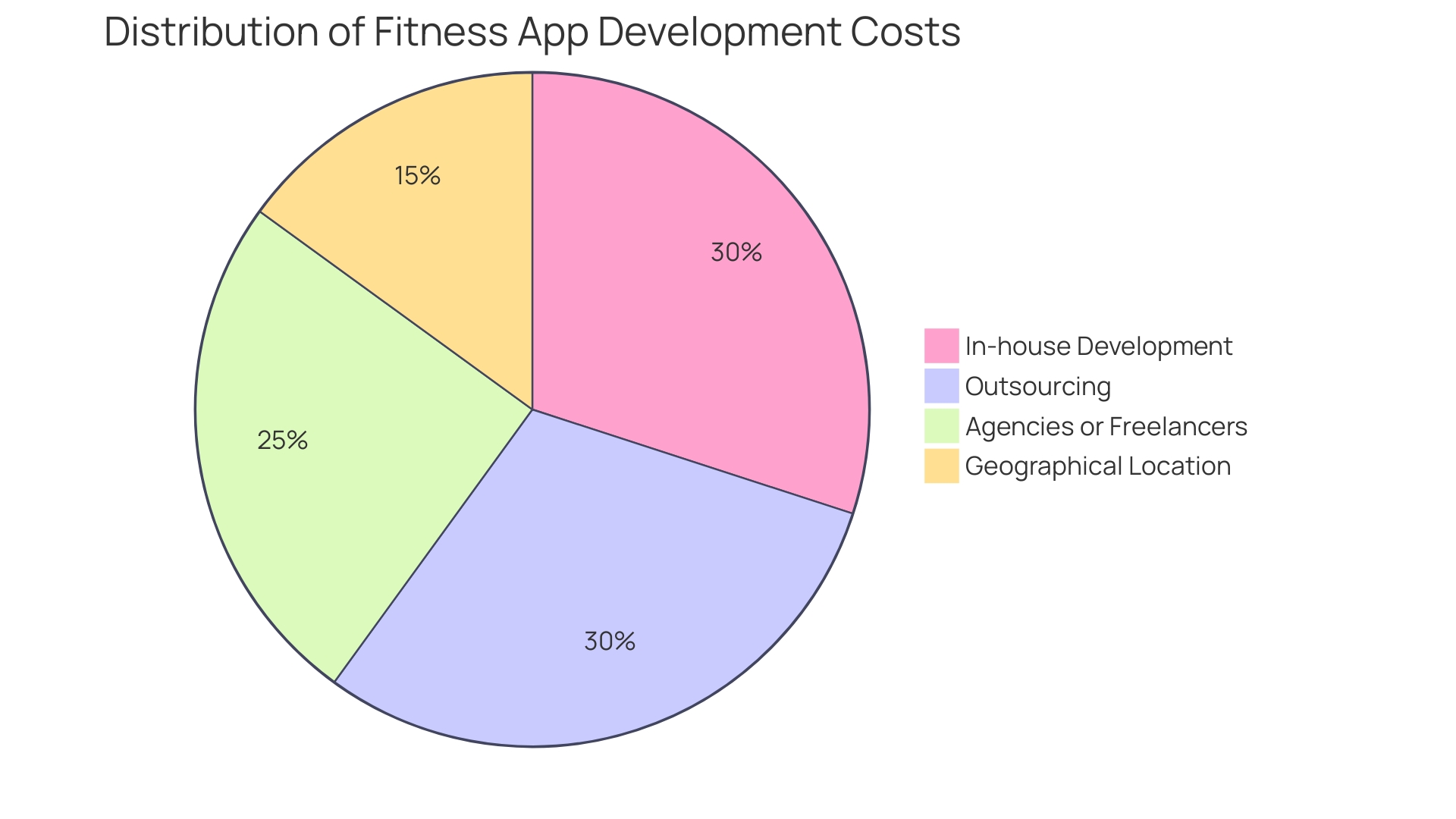Introduction
When it comes to developing a fitness app, understanding the factors that influence its cost is crucial. The financial investment for creating a mobile app can range from $10,000 to over $350,000, depending on various aspects such as the complexity of features and the choice of operating system.
This article will delve into the key considerations that affect fitness app development costs, including platform and tech stack choices, design complexity and user experience, integration with external services and APIs, development team composition and location, technical support and updates, and the cost comparison between building from scratch and using a pre-existing platform. By gaining insights into these factors, you can make informed decisions and optimize your budget for a successful fitness app venture.
Factors Affecting Fitness App Development Costs
Navigating the intricacies of fitness app development requires a keen understanding of the factors that dictate its cost. The financial investment for creating a mobile app can range significantly, starting at $10,000 and potentially exceeding $350,000.
This variance is influenced by numerous aspects, from the complexity of the app's features to the choice of operating system. For instance, the cost to acquire users for an Android app is traditionally less than that for iOS, a distinction attributed to the larger global user base of Android, particularly in regions like Latin America, Europe, and Asia.
As the demand for mobile apps escalates, with global downloads projected to generate over $613 billion in revenue by 2025, the strategic allocation of your budget towards development becomes ever more crucial. Each decision, be it the technical sophistication or the platform selection, plays a pivotal role in shaping the overall expenditure. Hence, a thorough analysis of these cost-influencing factors is indispensable for a judicious investment in your fitness app venture.
Platform and Tech Stack Considerations
When considering the development of a fitness app, it's vital to understand that platform choice and technology stack are pivotal elements that directly affect the cost. Opting for native development on iOS and Android platforms might incur higher expenses due to the separate codebases required for each.
On the other hand, cross-platform solutions offer a more budget-friendly alternative as they allow a single codebase to deploy on multiple platforms. The tech stack, encompassing programming languages, frameworks, and libraries, is another aspect that can sway the development budget.
Costs can range from $10,000 for basic apps to over $350,000 for complex, feature-rich applications. Statista's forecast of mobile app revenue reaching upwards of $613 billion by 2025 further underscores the significance of these decisions. Additionally, the cost to acquire app users varies by operating system, with Android typically seeing lower acquisition costs compared to iOS, due to its larger global user base. The choice of technology should not only consider cost but also performance—evaluation whether the chosen tech has a proven track record for efficiency and can handle the app's requirements is crucial.
Design Complexity and User Experience
The cost of mobile app development is a significant consideration for any business looking to establish a digital presence. It's a multifaceted investment that hinges on various factors, including the intricacy of the app's design and the caliber of user experience desired.
Aiming for a sophisticated and aesthetically pleasing interface with custom animations and intricate interactions will inevitably elevate the development costs. A design system that can evolve with your digital products is essential in this dynamic landscape, where the digital product ecosystem has grown in complexity, and the roles of design systems have expanded.
Moreover, the operating system for which the app is being developed plays a role in the overall cost. The global cost to acquire Android app users has consistently been lower than for iOS, influenced by the higher number of Android users, especially in regions like Latin America, Europe, and Asia. As such, the platform choice could affect both development costs and user acquisition expenses. With mobile app revenues projected to surpass $613 billion by 2025, striking the right balance between design complexity and user experience is crucial for optimizing costs and ensuring a successful app rollout.
Integration with External Services and APIs
Understanding the nuances of mobile app development costs is critical for ensuring a profitable investment. As mobile apps become increasingly integral to our daily routines, their development has emerged as a lucrative market, with projected revenues surpassing $613 billion by 2025.
However, the cost of development can vary significantly, ranging from $10,000 to upwards of $350,000. A pivotal factor in this cost variation is the integration of Application Programming Interfaces (APIs), which are indispensable in modern software development.
APIs facilitate communication between disparate software programs, acting as a translator and allowing for the creation of more sophisticated applications. As Google aptly describes, APIs are the 'crown jewel of software development', enhancing innovation and collaboration.
The complexity and quantity of these integrations can substantially influence the overall development budget. Therefore, it is essential to assess the necessity of each API integration meticulously, considering both its utility and the cost implications. With the global cost to acquire app users differing between iOS and Android—primarily due to the larger Android user base in regions like Latin America, Europe, and Asia—choosing the right operating system for your app can also impact development expenses. Ultimately, a comprehensive analysis of end-user needs and usage frequency is paramount when scoping your project and determining the most cost-effective approach to mobile app development.

Development Team Composition and Location
The cost of developing a fitness app is a multifaceted issue, and the team you choose plays a pivotal role in the financial outcome. Opting for in-house development or engaging with agencies or freelancers carries distinct cost ramifications. The geographical location of the team is another critical factor, influencing not only hourly rates but the total expenditure of the project.
With mobile app revenue projected to reach $613 billion by 2025, according to Statista, it's clear that mobile app development is a lucrative investment. However, costs can vary dramatically, from as little as $10,000 to over $350,000, based on several influencing factors. When considering outsourcing, it's worth noting that tapping into global talent pools in countries with lower living costs can yield significant savings.
Hiring developers from regions like India, Ukraine, or Vietnam could substantially lower hourly rates compared to their counterparts in the United States or Western Europe. Outsourcing doesn't just cut costs; it offers access to a broad spectrum of expertise and experience, which can be invaluable for specialized projects such as those involving blockchain or AI technologies. Therefore, when assembling your development team, weigh the pros and cons of each approach, keeping in mind both your budget and the specific needs of your fitness app project.

Technical Support and Updates
Maintaining the vitality of mobile applications is akin to nurturing a living ecosystem; it demands regular attention and care. Take the example of a legacy Android application, which, despite being complete and operational for years, encountered a critical issue when users were unable to log in after an update. This incident serves as a stark reminder that even well-established apps require diligent oversight.
Similarly, at DHIS2, a team manages an extensive suite of applications, including a comprehensive health information management system utilized across over 90 countries. Their approach underscores the importance of providing a robust infrastructure and toolset to ensure that their global community of developers can successfully maintain and update the applications. These real-world scenarios highlight the necessity of budgeting for ongoing technical support and updates to preserve app functionality, bolster security, and ensure compatibility with the latest devices and operating systems – all of which are essential for delivering a seamless user experience and staying abreast of market trends.
Cost Comparison: DIY vs. Using a Platform
When embarking on fitness app development, one must carefully weigh the financial implications of building an app from the ground up against the potential savings of utilizing a pre-existing platform. Custom development offers unparalleled personalization, but it's crucial to consider if this level of customization is necessary for the app's success.
Pre-built platforms can trim both costs and development time, yet it's important to investigate whether they can meet the performance standards and user engagement levels required for your project. Analyzing the frequency of user interaction and defining the appropriate metrics to measure cost-effectiveness are key in this decision-making process.
Additionally, with the mobile app market projected to yield over $613 billion by 2025, it's clear that investing in development is more pertinent than ever. Costs can range widely, from $10,000 to upwards of $350,000, influenced by various factors such as user needs, performance expectations, and the scope of the project. Therefore, a thorough evaluation of these elements is essential to align your app development with both your financial constraints and your strategic objectives.
Ways to Reduce the Cost of Fitness App Development
When embarking on the journey of fitness app development, it's crucial to balance cost-efficiency with quality. With Statista projecting mobile app revenues to hit $613 billion by 2025, it's clear that strategic investment in app development can lead to significant returns.
To keep development costs in check, without sacrificing the app's value, one must consider several tactics. Prioritizing features based on user demand and business objectives helps maintain focus and avoid overengineering.
Open-source frameworks and libraries can dramatically reduce development time and expenses, as they provide a foundation on which to build, bypassing the need to create common functionalities from scratch. Moreover, embracing agile methodologies like Scrum, characterized by its iterative nature and emphasis on collaboration and adaptability, can streamline the process and ensure continuous value delivery throughout the project.
This contrasts with the Waterfall approach, which, while more structured, may lead to increased costs if changes are required late in the development cycle. Managing the project scope meticulously is also paramount. Appinventiv, a company renowned for its custom software solutions, advocates for a thorough analysis of business needs and thoughtful technology stack selection to maximize development value. Their enterprise software development services are tailored to scale business infrastructure, enhancing key organizational facets and ensuring sustainable success. By adopting these strategies, developers can navigate the cost landscape of mobile app development, which varies widely from $10,000 to $350,000 and beyond, and deliver a robust fitness app that meets user expectations and business goals.
Conclusion
In conclusion, developing a fitness app requires careful consideration of factors that influence its cost. The investment can range from $10,000 to over $350,000, depending on features and the choice of operating system.
Platform and tech stack choices are crucial. Native development on iOS and Android may be costly, while cross-platform solutions offer a budget-friendly alternative.
Consider cost and performance when choosing technology. Design complexity and user experience impact costs.
Balancing sophistication with user-friendly design is essential for optimizing expenses. Integration with external services and APIs can substantially influence the overall budget.
Evaluate each integration carefully. The composition and location of the development team affect costs.
Outsourcing to countries with lower living costs can save money while providing expertise. Technical support and updates are crucial for maintaining app functionality.
Budget for ongoing support to ensure a seamless user experience. When considering cost-effective approaches, weigh building from scratch against using a pre-existing platform. Custom development offers personalization but may not always be necessary. Pre-built platforms can save costs if they meet performance standards. To reduce costs without compromising quality, prioritize features based on user demand and business objectives. Open-source frameworks, agile methodologies like Scrum, and project scope management streamline development. By understanding these factors, you can make informed decisions to optimize your budget while delivering a robust fitness app that meets user expectations in this rapidly growing market.
Ready to develop your fitness app and optimize your budget? Contact us now to get started!





